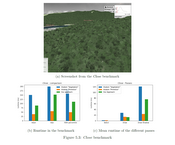Information
- Publication Type: Bachelor Thesis
- Workgroup(s)/Project(s): not specified
- Date: May 2024
- Date (Start): January 2024
- Date (End): May 2024
- Matrikelnummer: 11808244
- First Supervisor: Eduard Gröller
Abstract
Interactive visualization is important for many workflows. Especially so in the context of 3D geo-informations systems, where large quantities of data have to be processed and presented to the user at interactive speeds for productivity and orientation in the geo-spatial context. In heavily forested countries like Austria enormous amounts of geometry have to be drawn when visualizing forests. Naïve rendering approaches fail, even when using heavily simplified geometry for the individual trees. The region in which details are necessary is small and changes frequently. A major part of the scene is far away and needs little detail. These constraints are what this thesis attempts to find a solution for. Thus each tree is represented by a billboard, if not close to the camera. To decrease the computational complexity of selecting the appropriate level of detail for all trees, they are grouped into batches, for which frustum culling and level of detail selection happens. This new approach is implemented, qualitatively evaluated, and compared with existing alternative approaches. Comparison of the approaches on a stress test scene shows that our new approach can be between 1.7 and 6 times faster than the approaches tested against depending on the scenario, while barely reducing visual quality.Additional Files and Images
Weblinks
No further information available.BibTeX
@bachelorsthesis{eichner-2024-erv,
title = "Effizientes Rendern von W\"{a}ldern mittels Gruppierter
Detailgrade in 3D-Geoinformationssystemen",
author = "Anand Eichner",
year = "2024",
abstract = "Interactive visualization is important for many workflows.
Especially so in the context of 3D geo-informations systems,
where large quantities of data have to be processed and
presented to the user at interactive speeds for productivity
and orientation in the geo-spatial context. In heavily
forested countries like Austria enormous amounts of geometry
have to be drawn when visualizing forests. Naïve rendering
approaches fail, even when using heavily simplified geometry
for the individual trees. The region in which details are
necessary is small and changes frequently. A major part of
the scene is far away and needs little detail. These
constraints are what this thesis attempts to find a solution
for. Thus each tree is represented by a billboard, if not
close to the camera. To decrease the computational
complexity of selecting the appropriate level of detail for
all trees, they are grouped into batches, for which frustum
culling and level of detail selection happens. This new
approach is implemented, qualitatively evaluated, and
compared with existing alternative approaches. Comparison of
the approaches on a stress test scene shows that our new
approach can be between 1.7 and 6 times faster than the
approaches tested against depending on the scenario, while
barely reducing visual quality.",
month = may,
address = "Favoritenstrasse 9-11/E193-02, A-1040 Vienna, Austria",
school = "Research Unit of Computer Graphics, Institute of Visual
Computing and Human-Centered Technology, Faculty of
Informatics, TU Wien ",
URL = "https://www.cg.tuwien.ac.at/research/publications/2024/eichner-2024-erv/",
}



